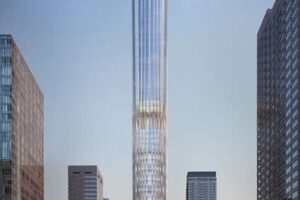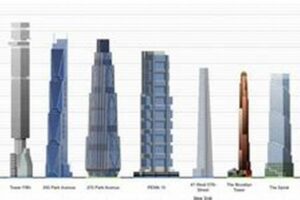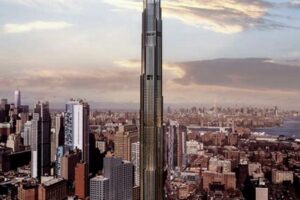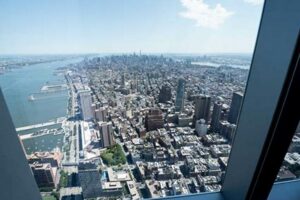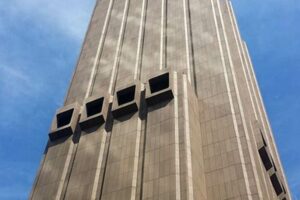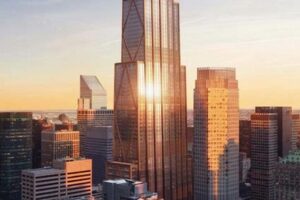Super slender skyscrapers in New York City are a relatively new phenomenon, but they have quickly become iconic symbols of the city’s skyline. These buildings are characterized by their extremely thin profiles, which often give them a pencil-like appearance. The first super slender skyscraper in New York City was the Trump World Tower, which was completed in 2001. Since then, a number of other super slender skyscrapers have been built in the city, including 432 Park Avenue, Central Park Tower, and 111 West 57th Street. Super slender skyscrapers are often praised for their sleek and modern designs, but they have also been criticized for their lack of affordability and their impact on the city’s skyline.
One of the main benefits of super slender skyscrapers is their ability to maximize views and natural light. The thin profiles of these buildings allow for large windows that offer panoramic views of the city. Super slender skyscrapers are also often built with floor-to-ceiling windows, which allow for natural light to flood into the units. This can help to reduce energy costs and create a more comfortable living environment.
Another benefit of super slender skyscrapers is their ability to fit into tight spaces. The thin profiles of these buildings allow them to be built on narrow lots or in areas where there is limited space. This can be a major advantage in dense urban environments like New York City, where land is at a premium.
However, super slender skyscrapers also have some drawbacks. One of the main concerns is their lack of affordability. These buildings are often very expensive to construct and maintain, which can make them unaffordable for many people. Additionally, super slender skyscrapers can have a negative impact on the city’s skyline. Their thin profiles can make them look out of place in some neighborhoods, and they can also block views of other buildings.
Despite these drawbacks, super slender skyscrapers remain a popular choice for developers and architects in New York City. Their sleek designs and panoramic views make them highly desirable, and their ability to fit into tight spaces makes them a valuable asset in dense urban environments.
1. Height
The height of super slender skyscrapers is a key defining characteristic of these buildings, and it is one of the things that makes them so iconic. The first super slender skyscraper in New York City was the Trump World Tower, which was completed in 2001 and stands at 900 feet tall. Since then, a number of other super slender skyscrapers have been built in the city, including 432 Park Avenue, which is the tallest residential building in the world at 1,396 feet tall.
There are several reasons why developers and architects choose to build super slender skyscrapers. One reason is that height can be a major selling point for luxury apartments and condos. Buyers are willing to pay a premium for units with stunning views of the city, and the higher the building, the better the views. Additionally, height can be a way to maximize the amount of rentable space on a given plot of land. By building a super slender skyscraper, developers can fit more units into a smaller footprint, which can be a major advantage in dense urban environments like New York City.
However, there are also some challenges associated with building super slender skyscrapers. One challenge is that these buildings can be more difficult to design and engineer than traditional skyscrapers. The extreme height and thinness of these buildings can make them more susceptible to wind and seismic forces. Additionally, super slender skyscrapers can be more expensive to construct and maintain than traditional skyscrapers.
Despite these challenges, super slender skyscrapers continue to be a popular choice for developers and architects in New York City. These buildings offer stunning views, innovative design, and a glimpse into the future of urban architecture.
2. Thinness
The thinness of super slender skyscrapers is a key defining characteristic of these buildings, and it is one of the things that makes them so distinctive. There are several reasons why architects and developers choose to build super slender skyscrapers, but one of the main reasons is to maximize views and natural light. The thin profiles of these buildings allow for large windows and floor-to-ceiling glass facades, which offer panoramic views of the city. Additionally, the thinness of super slender skyscrapers can help to reduce wind resistance and seismic forces, making them more efficient and sustainable.
- Engineering Challenges: The thinness of super slender skyscrapers presents a number of engineering challenges. These buildings are more susceptible to wind and seismic forces than traditional skyscrapers, and they require specialized design and construction techniques to ensure their stability. For example, super slender skyscrapers often use a diagrid structural system, which consists of a network of diagonal beams that helps to distribute loads more evenly.
- Material Innovation: The thinness of super slender skyscrapers also requires the use of innovative materials. Traditional building materials, such as concrete and steel, are too heavy for use in these buildings. Instead, architects and engineers use lightweight materials, such as carbon fiber and glass-reinforced concrete, to reduce the weight of the building.
- Sustainability: The thinness of super slender skyscrapers can also contribute to their sustainability. The large windows and floor-to-ceiling glass facades allow for natural light to flood into the building, which can reduce the need for artificial lighting. Additionally, the use of lightweight materials can help to reduce the building’s overall carbon footprint.
The thinness of super slender skyscrapers is a key defining characteristic of these buildings, and it is one of the things that makes them so iconic. These buildings offer stunning views, innovative design, and a glimpse into the future of urban architecture.
3. Views
The panoramic views offered by super slender skyscrapers are one of their most defining characteristics. The large windows and floor-to-ceiling glass facades of these buildings allow residents and visitors to enjoy stunning views of the city from every room. This is a major selling point for luxury apartments and condos, and it is one of the reasons why super slender skyscrapers have become so popular in New York City.
- Unparalleled Views: The views from super slender skyscrapers are unparalleled. These buildings offer a bird’s-eye view of the city, and residents can see for miles in every direction. This is a major advantage over traditional skyscrapers, which often have obstructed views due to neighboring buildings.
- Natural Light: The large windows and floor-to-ceiling glass facades of super slender skyscrapers also allow for an abundance of natural light. This can help to reduce energy costs and create a more comfortable living environment. Additionally, natural light has been shown to have a number of health benefits, including improved mood and sleep quality.
- Sense of Space: The large windows and floor-to-ceiling glass facades of super slender skyscrapers can also create a sense of space. These buildings often have open floor plans and high ceilings, which can make them feel more spacious than they actually are.
- Architectural Landmark: The panoramic views offered by super slender skyscrapers are also a major architectural landmark. These buildings are instantly recognizable, and they have become a symbol of New York City’s skyline. They are a testament to the ingenuity and creativity of architects and engineers.
The panoramic views offered by super slender skyscrapers are one of their most defining characteristics. These views are unparalleled, and they offer a unique perspective on the city. They are also a major selling point for luxury apartments and condos, and they are one of the reasons why super slender skyscrapers have become so popular in New York City.
4. Density
In the context of “super slender skyscrapers nyc”, the density of New York City is a key factor that has contributed to the development of these unique buildings. The high cost of land in New York City makes it difficult to build traditional skyscrapers, which require large footprints. Super slender skyscrapers, on the other hand, can be built on narrow lots and in dense urban environments, where land is at a premium.
- Space Optimization: Super slender skyscrapers are designed to maximize space efficiency. Their thin profiles allow them to fit into tight spaces and on narrow lots, which would not be possible with traditional skyscrapers. This is a major advantage in dense urban environments like New York City, where land is scarce and expensive.
- Mixed-Use Development: Super slender skyscrapers often incorporate mixed-use development, which allows for a variety of uses within a single building. This can include residential units, office space, retail space, and public amenities. Mixed-use development is a valuable way to maximize the use of space in dense urban environments.
- Transit-Oriented Development: Super slender skyscrapers are often built near public transportation hubs, which makes them convenient for residents and visitors. This is an important factor in dense urban environments, where traffic congestion can be a major problem. Transit-oriented development can help to reduce traffic congestion and promote sustainable transportation.
- Vertical Communities: Super slender skyscrapers create vertical communities, which offer a sense of place and belonging for residents. These communities can also provide a variety of amenities and services, such as fitness centers, swimming pools, and rooftop gardens. Vertical communities are a valuable asset in dense urban environments, where open space is limited.
The density of New York City has been a major factor in the development of super slender skyscrapers. These buildings offer a number of advantages in dense urban environments, including space optimization, mixed-use development, transit-oriented development, and vertical communities. Super slender skyscrapers are a unique and innovative response to the challenges of building in dense urban environments, and they are a testament to the ingenuity and creativity of architects and engineers.
5. Cost
The high cost of super slender skyscrapers is a major factor that limits their affordability for many people. The construction of these buildings requires specialized materials and engineering techniques, which can be very expensive. Additionally, the maintenance of super slender skyscrapers is also more expensive than traditional skyscrapers, due to their complex structural systems and mechanical equipment.
The high cost of super slender skyscrapers has a number of implications for the city of New York. One implication is that these buildings are often only affordable for the very wealthy. This can lead to a lack of diversity in the city’s population, as well as a shortage of affordable housing options for middle-class and low-income residents.
Another implication of the high cost of super slender skyscrapers is that it can make it difficult for businesses to locate in New York City. The high cost of office space in super slender skyscrapers can be a major deterrent for businesses, especially small businesses and startups. This can lead to a loss of jobs and economic growth in the city.
The high cost of super slender skyscrapers is a complex issue with a number of implications for the city of New York. It is important to consider the costs and benefits of these buildings when making decisions about their construction and use.
6. Wind resistance
Wind resistance is a major consideration in the design and construction of super slender skyscrapers in New York City. These buildings are extremely tall and thin, which makes them more susceptible to wind forces than traditional skyscrapers. However, super slender skyscrapers are designed with a number of features that help them to withstand high winds, including:
- Structural systems: Super slender skyscrapers often use a diagrid structural system, which consists of a network of diagonal beams that helps to distribute wind loads more evenly. This system is more efficient and lightweight than traditional steel frames, and it helps to reduce the amount of sway in the building.
- Aerodynamic design: Super slender skyscrapers are often designed with aerodynamic features that help to reduce wind resistance. These features can include curved facades, setbacks, and fins. These features help to break up the wind flow and reduce the amount of force that is exerted on the building.
- Damping systems: Super slender skyscrapers often use damping systems to reduce sway. These systems can include tuned mass dampers, which are large weights that are suspended from the top of the building. These weights move in opposition to the building’s sway, which helps to reduce the amount of movement.
Despite these design features, super slender skyscrapers can still sway in strong gusts of wind. However, the amount of sway is typically within acceptable limits, and it does not pose a safety hazard. In fact, some people find the swaying of super slender skyscrapers to be a thrilling experience.
The wind resistance of super slender skyscrapers is a complex topic, but it is an important one to consider when designing and constructing these buildings. By understanding the forces that are involved, engineers can design buildings that are safe and stable, even in the strongest winds.
7. Sustainability
Super slender skyscrapers in New York City are renowned for their sleek and modern designs, but they also offer a number of sustainability benefits. One of the key ways that super slender skyscrapers can be energy efficient is through the use of natural light. The large windows and floor-to-ceiling glass facades of these buildings allow for an abundance of natural light to flood into the building, which can reduce the need for artificial lighting. Additionally, the use of innovative building materials can also contribute to the energy efficiency of super slender skyscrapers. For example, some super slender skyscrapers use lightweight materials, such as carbon fiber and glass-reinforced concrete, which can reduce the overall weight of the building and make it more energy efficient to operate.
The sustainability of super slender skyscrapers is an important factor to consider when evaluating these buildings. By using natural light and innovative building materials, super slender skyscrapers can reduce their energy consumption and environmental impact. This is a major advantage for these buildings, especially in a city like New York City, where energy costs are high and environmental concerns are a priority.
One example of a super slender skyscraper that incorporates sustainability features is 432 Park Avenue. This building uses a diagrid structural system, which is more efficient and lightweight than traditional steel frames. Additionally, 432 Park Avenue uses low-emissivity glass, which helps to reduce heat loss and gain. These features contribute to the building’s energy efficiency and make it one of the most sustainable super slender skyscrapers in New York City.
The sustainability of super slender skyscrapers is a complex topic, but it is an important one to consider. By understanding the ways that these buildings can be energy efficient, we can make informed decisions about their construction and use. Super slender skyscrapers can be a valuable part of a sustainable future for New York City.
8. Aesthetics
Super slender skyscrapers have a distinctive appearance that sets them apart from other buildings in the New York City skyline. Their thin, pencil-like profiles and glass facades give them a modern and elegant look that is often praised by architects and design critics. However, super slender skyscrapers have also been the subject of controversy, with some critics arguing that they are out of place in the city’s skyline and that they disrupt the city’s traditional architectural aesthetic.
One of the main criticisms of super slender skyscrapers is that they are too tall and thin. Critics argue that these buildings are out of scale with the rest of the city’s architecture and that they create a sense of visual clutter in the skyline. Additionally, critics argue that the glass facades of super slender skyscrapers reflect too much sunlight, which can be a nuisance for people living and working in nearby buildings.
Despite the controversy, super slender skyscrapers continue to be built in New York City. Developers are attracted to these buildings because they can be built on small lots and offer panoramic views of the city. Additionally, super slender skyscrapers are often seen as a status symbol, and wealthy individuals and corporations are willing to pay a premium to live or work in one of these buildings.
The debate over the aesthetics of super slender skyscrapers is likely to continue as these buildings become more common in New York City. However, it is clear that these buildings have a significant impact on the city’s skyline and that they are a major part of the city’s architectural landscape.
FAQs about Super Slender Skyscrapers in New York City
Super slender skyscrapers have become a defining feature of the New York City skyline, but they have also been the subject of controversy. Here are some frequently asked questions about these unique buildings:
Question 1: What are super slender skyscrapers?
Super slender skyscrapers are buildings with a height-to-width ratio of at least 10:1. This means that they are extremely tall and thin, and they often have a pencil-like appearance.
Question 2: What is the tallest super slender skyscraper in New York City?
Central Park Tower is the tallest super slender skyscraper in New York City, standing at 1,550 feet tall.
Question 3: Are super slender skyscrapers safe?
Super slender skyscrapers are designed to withstand high winds and seismic forces. They use a variety of engineering techniques to ensure their stability, including diagrid structural systems and damping systems.
Question 4: Are super slender skyscrapers sustainable?
Super slender skyscrapers can be energy efficient due to their use of natural light and innovative building materials. However, they can also be criticized for their use of resources and their impact on the urban environment.
Question 5: Are super slender skyscrapers affordable?
Super slender skyscrapers are typically very expensive to construct and maintain. This makes them unaffordable for many people, and they are often criticized for contributing to the lack of affordable housing in New York City.
Question 6: Are super slender skyscrapers a good addition to the New York City skyline?
The aesthetics of super slender skyscrapers are a matter of opinion. Some people find them to be elegant and modern, while others find them to be out of place and disruptive to the city’s traditional architectural aesthetic.
Super slender skyscrapers are a complex and controversial topic. There are many factors to consider when evaluating these buildings, including their safety, sustainability, affordability, and aesthetics. Ultimately, it is up to each individual to decide whether or not they believe super slender skyscrapers are a good addition to the New York City skyline.
Transition to the next article section: Super slender skyscrapers are a major part of the New York City skyline, and they are likely to continue to be built in the years to come. It is important to understand the benefits and drawbacks of these buildings so that we can make informed decisions about their construction and use.
Tips for Super Slender Skyscrapers in New York City
Super slender skyscrapers are a unique and challenging building type, but they can also be a valuable addition to the New York City skyline. Here are a few tips for designing and constructing super slender skyscrapers:
Tip 1: Use a diagrid structural system.
A diagrid structural system is a network of diagonal beams that helps to distribute wind loads more evenly. This system is more efficient and lightweight than traditional steel frames, and it helps to reduce the amount of sway in the building.
Tip 2: Incorporate aerodynamic features.
Super slender skyscrapers can be designed with aerodynamic features that help to reduce wind resistance. These features can include curved facades, setbacks, and fins. These features help to break up the wind flow and reduce the amount of force that is exerted on the building.
Tip 3: Use damping systems.
Super slender skyscrapers can use damping systems to reduce sway. These systems can include tuned mass dampers, which are large weights that are suspended from the top of the building. These weights move in opposition to the building’s sway, which helps to reduce the amount of movement.
Tip 4: Consider the use of natural light.
The large windows and floor-to-ceiling glass facades of super slender skyscrapers allow for an abundance of natural light to flood into the building. This can reduce the need for artificial lighting and create a more comfortable living environment. Additionally, natural light has been shown to have a number of health benefits, including improved mood and sleep quality.
Tip 5: Use sustainable building materials.
The use of sustainable building materials can help to reduce the environmental impact of super slender skyscrapers. For example, some super slender skyscrapers use lightweight materials, such as carbon fiber and glass-reinforced concrete, which can reduce the overall weight of the building and make it more energy efficient to operate.
By following these tips, architects and engineers can design and construct super slender skyscrapers that are safe, sustainable, and beautiful.
Conclusion: Super slender skyscrapers are a complex and challenging building type, but they can also be a valuable addition to the New York City skyline. By understanding the challenges and opportunities involved in designing and constructing these buildings, we can create super slender skyscrapers that are safe, sustainable, and beautiful.
Conclusion
Super slender skyscrapers have become a defining feature of the New York City skyline. These buildings are characterized by their extremely thin profiles and glass facades, which give them a modern and elegant appearance. However, super slender skyscrapers have also been the subject of controversy, with some critics arguing that they are out of place in the city’s traditional architectural landscape and that they disrupt the city’s sense of scale.
Despite the controversy, super slender skyscrapers continue to be built in New York City. Developers are attracted to these buildings because they can be built on small lots and offer panoramic views of the city. Additionally, super slender skyscrapers are often seen as a status symbol, and wealthy individuals and corporations are willing to pay a premium to live or work in one of these buildings.
The debate over the aesthetics of super slender skyscrapers is likely to continue as these buildings become more common in New York City. However, it is clear that these buildings have a significant impact on the city’s skyline and that they are a major part of the city’s architectural landscape.
As we look to the future, it is important to consider the benefits and drawbacks of super slender skyscrapers. These buildings can offer a number of advantages, including energy efficiency, sustainability, and panoramic views. However, they can also be expensive to construct and maintain, and they can have a negative impact on the city’s skyline and sense of scale.
Ultimately, the decision of whether or not to build more super slender skyscrapers in New York City is a complex one. There are many factors to consider, including the city’s architectural heritage, its need for affordable housing, and its environmental goals. It is important to weigh all of these factors carefully before making a decision.


